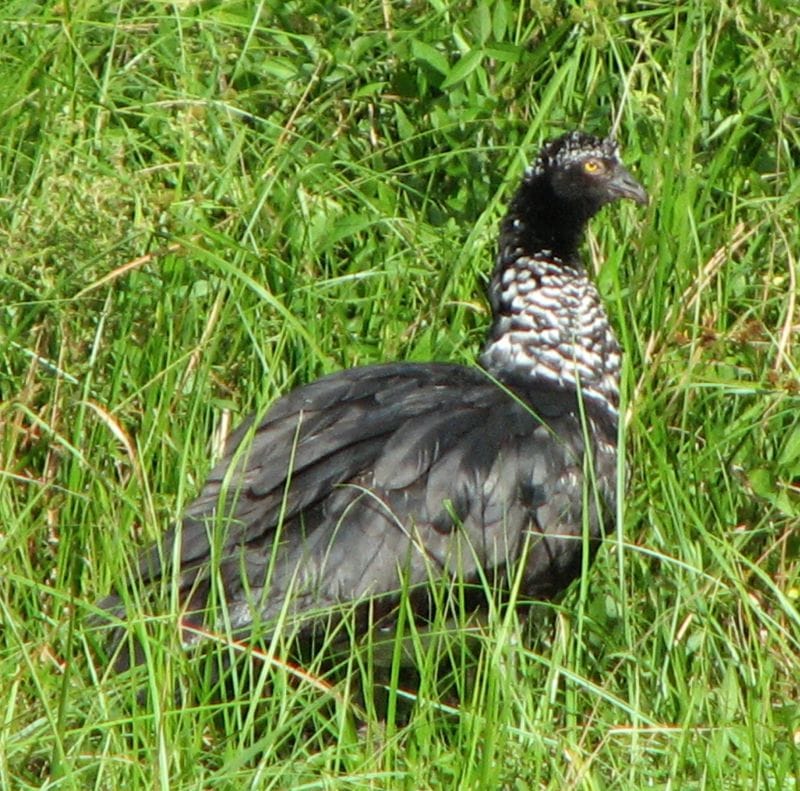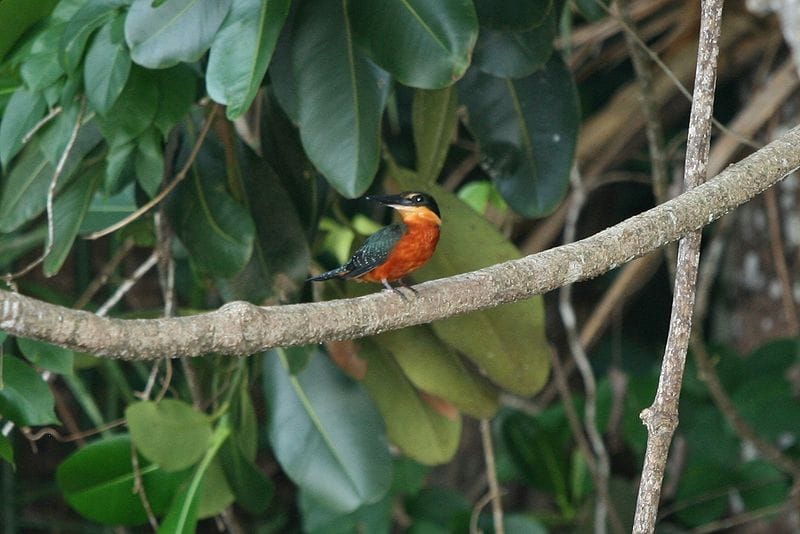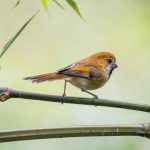Brazil is an amazing country loaded with a huge number of species of bird that birders the world over desperately want to experience. As part of the Wildlife Conservation Society Birds of Brazil giveaway we asked readers of 10,000 Birds to name the bird in Brazil that they would like to see more than any other species. What follows are the responses that readers offered, a veritable aviary of sought after species.
Arie Gilbert would like to see and share a Hoatzin (and he should be punished for a horrific pun):
I would like to see the Hoatzin. It is a really neat bird that I have not seen before. It would mean that I was birding in a really cool place! But I would also relish the opportunity to spot one and yell: “Hoatzin! Come quickly!”
Robert Meehan reluctantly narrowed down his choices to the wonderfully named Horned Screamer.
If I had to choose just one Brazilian bird to see (painful!) it would probably be the Horned Screamer. Screamers of all types are awesome, but of all of them, the Horned Screamer is the weirdest and perhaps most beautiful. Seeing that giant piebald bird with a random horn growing out of its forehead standing in an open Brazilian marsh would be a real treat. Plus, I mean, it’s a giant chicken-looking thing that’s actually related to ducks… with that kind of identity crisis going on, what’s not to love?
Horned Screamer
Michael McDonald is a lot like Wile E Coyote and would like to see a Rufous-vented Ground-cuckoo!
My most-desired Brazilian bird? Easily, it’s the Rufous-vented Ground-cuckoo (Neomorphus geoffroyi). A rare and coveted find anywhere in its range, but possibly even more so in Brazil, where one subspecies, N.g.maximiliani, has already been lost and another, N.g.dulcis, is on the verge of extinction. I’ve spent the past few years in pursuit of roadrunners and would love nothing more than to someday give chase to the other New World Ground-cuckoos.
Ellen Kessler, like many birders the world over, would like to see a Spix’s Macaw.
Living in Colorado, I was practically next door neighbors to a Spix’s Macaw, “Presley,” who was discovered in an Evergreen living room—the only known Spix’s Macaw in the United States—and who was repatriated to Brazil before I even knew he existed. And I hugged a woman who was lucky enough to hold a Spix’s Macaw at the Al Wabra Wildlife Preservation in Qatar while on vacation in the Middle East some years ago. But this critically endangered and majestic blue parrot has remained elusive to most of the world and, sniffle sniffle, to me as well. While it’s no longer possible to see this regal macaw soar gracefully through the Brazilian skies, to be able to worship them—even from afar at one of the conservatories or zoos—would be a dream, at last, come true.
Karla Lucas feels the same way about Spix’s Macaw!
The Brazilian bird I would most like to see is the Spix’s Macaw. It was once an endemic bird, lovely to look at. Now, none exist in the wild. It would be a terrible shame to see it’s liveliness, and loveliness, go extinct.
Ashli Gorbet picked a wood-warbler, the White-striped Warbler, which would have served her well had this contest not been based on a random drawing.
I can virtually guarantee that I will be the only person for whom the endemic White-striped Warbler (Basileuterus leucophrys) rests at the very top of the list of most desired Brazilian bird species. This subtly plumaged, tail-flashing, ground-faring warbler has an outrageously gorgeous song of tinkling trills and whistles. Its riparian haunts are quickly disappearing, and it may be soon before we are threatened with the loss of another species we know very little about. In my life’s quest to see every wood-warbler (I’m half-way there), this bird will necessitate a special trip, deservedly so.
Molly Schulman would like no Brazilian bird more than a Magnificent Frigatebird.
The Magnificent Frigatebird is the bird I would want to see. Though not a rare bird, it’s tireless flight, day and night, I find alluring. Not to mention, its brilliantly bulbous crimson throat, bloated during breeding season must be a sight! To see this bird in all its glory in the environs of Brazil would be my bird dream.
Dana Komorowski has a thing for motmots, particularly the Blue-crowned Motmot.
I would love to see any species of motmot, but mostly a Blue-crowned Motmot because of their sheer beauty. I worked with a pair of motmots at a US zoo and fell in love with their vibrant colors and unique tails. I would love to see them one day in their natural habitat and possibly see the tail-wagging behavior in action! I love sexual behavior studies, and the motmot tail is an excellent and beautiful example of mother nature at her finest!
Jacob Drucker decided to get all kinds of obscure and chose Stresemann’s Bristlefront as his most wanted Brazilian bird.
Though singling out one Brazilian bird in particular is a truly difficult task, given the variety of stunning birds in the country, I must say that Stresemann’s Bristlefront captures my imagination the most. For every brilliant bird like Araripe Manakin or the visorbearers, there are even more obscure birds whose beauty is in their oddity, subtlety and individuality, and the two species of Bristlefronts–both endemic to Brazil, are perfect examples of these. However, the Stresemann’s Bristlefront is one of those birds that is simply enigmatic and rare and recently discovered, with many aspects of its life history unknown to humanity. This kind of ability to evade the reaches of humanity is what to me makes a bird truly amazing, and this is why I would like to see a Stresemann’s Bristlefront so much.
Duncan Wright would really like to see anything in Brazil but he would especially like to see a Kinglet Calyptura.
The bird I most want to see in Brazil is the Kinglet Calyptura. Its a small gem of a bird of uncertain affinities, bit possibly its a tyrant-flycatcher. There are two reasons I’d like to see it, firstly it would mean that I was in Brazil if I saw it, and getting to Brazil is a priority. Secondly, it would mean that this rarely seen endemic is not yet extinct.
Adrienne Weber would like to see and (and especially hear) a Southern Screamer.
The bird I would most want to see if I went birding in Brazil would be the Southern Screamer. I not only want to see the Southern Screamer, but I really want to hear the Southern Screamer, basically because of the name screamer. I have heard tapes of its scream, but never heard it in person. I would love venturing out near an estuary in Brazil and see a Southern Screamer walking around and hear it let out a scream!!!
Jean Loscalzo is a penguin buff (Can you blame her?) and would love to watch Rockhopper Penguins.
My Brazilian wish bird would be Rockhopper Penguin: raucous, feisty birds with really cool haircuts, a sort of disheveled yellow-black shaggy look that they wear well. I once watched a special on the species that showed them repeatedly lining up on the edges of rocks until a large wave from rough surf would crash over them, sweeping them away into the water. They really appeared to enjoy this, because as soon as they swam back to the rocks they would line up again to repeat the experience. It seemed like a really fun way to spend the day!
John Marvin has had a near lifelong wish to see a Jabiru.
The Brazilian bird I would most like to see is the Jabiru. My first tropical birding trip was to Costa Rica when I was 8 and the Jabiru was at the top of my list even then, but sadly none were encountered. Since then I’ve birded the neotropics a number of times and still no Jabiru. Hopefully a new and much superior bird guide to the Pantanal region can be the impetus to search them out in some of their preferred habitat.
Paul Riss wants to see everything. His very brief paragraph is:
I want to see them all. Please. Please. Please.
Jan Axel also wants to see them all but he managed to cut his wish list down to one, oddly, the same bird that Duncan picked, the Kinglet Calyptura:
The Brazilian bird I would most like to see is… ALL OF THEM, so I definitively need that book. Well, serious now, I really want to see a Kinglet Calyptura because is so rare and enigmatic, thought to be extinct, refound and now disappeared again. Simply amazing, endemic and with still dubious relations (it is a cotinga, a flycatcher or something else by its own?). I can imagine myself inside the Brazilian Atlantic Rain Forest (with the book in my bag), checking every movement, searching for this almost legendary creature and of course jumping in joy when finding it!
Erika Wilson would like to see a Green-and-rufous Kingfisher in order to complete a set of sightings.
The Green-and-rufous Kingfisher Chloroceryle inda is the species I would most like to see in Brazil. I have been to Brazil twice, both times within this species’ range, but I have failed to see one. Green-and-rufous Kingfisher is the only Cholorceryle species I haven’t seen, so observing one would complete a genus in this fascinating family. Seeing a Green-and-rufous Kingfisher take a crab would be the best behavioral sighting I can imagine.
Green-and-rufous Kingfisher by Arthur Chapman (released under a Creative Commons license)
Tom Dulski chose an incredibly cool bird of the night, the Sickle-winged Nightjar.
OK I’ll give this a shot. It would be easy to choose something Iconic like a Hyacinth Macaw or exotic like a Capuchinbird. However if I had to choose one bird to see in Brazil it would be a Sickle-Winged Nightjar. The wings on the male are remarkably shaped plus I’ve always had an peculiar interest in the nightjar family.
…














Clearly Jan and I need to organise an expedition to rediscover the Kinglet Calyptura.
Interesting choices, and congratulations to the winner! Duncan, I’ll look forward for it!
There’s a birder in NJ with the last named Kevin Watson whose email address is kevinhoatzin. I thought that was clever.
I like to think that Hoatzins are the best representative of the Amazon avifauna and Horned screamers remind me the time elephants “had wings”
@Duncan: a very good friend of mine is Martin Schaefer, a name that might sound familiar to those who have researched Kinglet Calyptura a bit. He told me quite a bit about his observation – sadly “undocumented”.